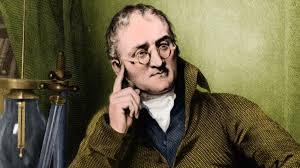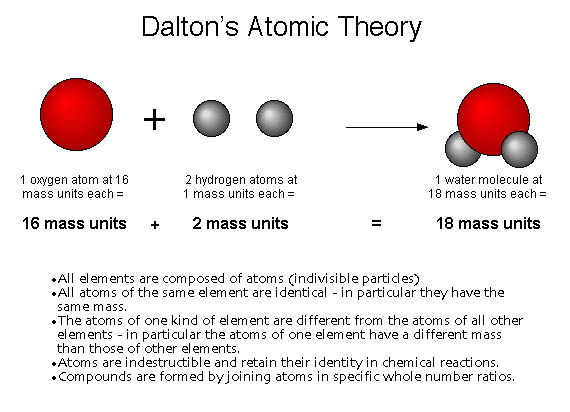JOHN DALTON (1803)

It was in the early 1800s that John Dalton, an observer of weather and discoverer of color blindness among other things, came up with his atomic theory. Let's set the stage for Dalton's work. Less than twenty years earlier, in the 1780's, Lavoisier ushered in a new chemical era by making careful quantitative measurementswhich allowed the compositions of compounds to be determined with accuracy. By 1799 enough data had been accumulated for Proust to establish the Law of Constant Composition ( also called the Law of Definite Proportions). In 1803 Dalton noted that oxygen and carbon combined to make two compounds. Of course, each had its own particular weight ratio of oxygen to carbon (1.33:1 and 2.66:1), but also, for the same amount of carbon, one had exactly twice as much oxygen as the other. This led him to propose the Law of Simple Multiple Proportions, which was later verified by the Swedish chemist Berzelius. In an attempt to explain how and why elements would combine with one another in fixed ratios and sometimes also in multiples of those ratios, Dalton formulated his atomic theory.
The idea of atoms had been proposed much earlier. The ancient Greek philosophers had talked about atoms, but Dalton's theory was different in that it had the weight of careful chemical measurements behind it. It wasn't just a philosophical statement that there are atoms because there must be atoms. His atomic theory, stated that elements consisted of tiny particles called atoms. He said that the reason an element is pure is because all atoms of an element were identical and that in particular they had the same mass. He also said that the reason elements differed from one another was that atoms of each element were different from one another; in particular, they had different masses. He also said that compounds consisted of atoms of different elements combined together. Compounds are pure substances (remember they cannot be separated into elements by phase changes) because the atoms of different elements are bonded to one another somehow, perhaps by hooks, and are not easily separated from one another. Compounds have constant composition because they contain a fixed ratio of atomsand each atom has its own characteristic weight, thus fixing the weight ratio of one element to the other. In addition he said that chemical reactions involved the rearrangement of combinations of those atoms.
